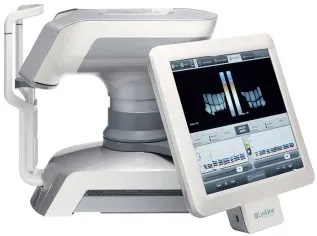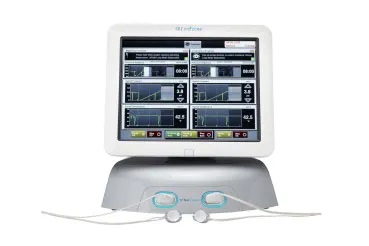
Dry eye syndrome (DES) is a chronic condition that develops when your eyes do not produce and maintain enough tears to keep the eye’s surface lubricated resulting in multiple symptoms that range from person to person. This can be due to a reduction in tear production or increased tear evaporation from a lack of lipid in the tears that stem from oil glands in the eyelids. The effects can range from minor dryness and discomfort to pain, blurred vision and frequent infections.
Symptoms of Dry Eye Disease
Symptoms of dry eye syndrome can vary depending on the severity of the condition but can include:
- Dry, itchy eyes
- Burning or stinging
- Irritation
- Watery eyes
- Blurred vision
- Pain
- Foreign body sensation
The main function of tears is to maintain the health of the cornea of your eye by washing away foreign matter and ensuring that the surface of your eye remains moist, smooth and clear. Tears also rinse away dust particles from your eyes and contain enzymes that protect your eyes from bacteria that can cause infections. Dry eyes is a condition that develops when the amount of tears produced is not sufficient to maintain the moisture balance in your eye. This can result in that scratchy sensation, a continuous feeling of dryness, stinging and a sensation of a foreign body in your eye. Ironically in an effort to fight off the condition, dry eyes can cause you to produce excessive tears, which is why some people experience watery eyes.
Causes of Dry Eye Disease
Dry eyes can occur naturally as a result of aging or hormonal changes, typically in women who are pregnant, taking oral contraceptives or going through menopause. In fact, women over 50 have a 50% greater risk of dry eye disease than men do of the same age. It can also result from taking certain medications that reduce tear production such as antihistamines, blood pressure medications and antidepressants. Environmental factors can also play a role in drying out the eyes and DED is common in areas where the climate is dry, dusty and windy. Home air conditioners or heating systems and excessive time spent staring at a computer or television screen can also dry out eyes and exacerbate symptoms due to the lack of blinking while staring at our screens.
Individuals that suffer from certain medical conditions such as diabetes, blepharitis, lupus, arthritis and thyroid problems are more vulnerable to developing DED. Other causes can be due to eye surgery including LASIK, certain conditions in which the eyelids don’t close properly or extended contact lens use.
How do we determine if you are suffering from Dry Eye?
 In our Dry Eye Clinic we will conduct a series of uations and determine the likely cause of your Dry Eye symptoms. First, you will complete a Dry Eye lifestyle questionnaire- this brief assessment allows us to to understand how your eyes feel on a daily basis. If the questionnaire indicates symptoms beyond mild, we will proceed with LipView®– this technology allows the physician to uate the lipid (oil) layer on your eye.
In our Dry Eye Clinic we will conduct a series of uations and determine the likely cause of your Dry Eye symptoms. First, you will complete a Dry Eye lifestyle questionnaire- this brief assessment allows us to to understand how your eyes feel on a daily basis. If the questionnaire indicates symptoms beyond mild, we will proceed with LipView®– this technology allows the physician to uate the lipid (oil) layer on your eye.
The procedure is non-invasive, can be performed in our office, and takes less than five minutes. If you’ve ever had a comprehensive eye exam, LipiView® will feel similar. The tear film can be clearly seen as an array of colors that are reflected when a light source is directed towards the front surface of the eye. Readings are instantly calculated and displayed on the LipiView® monitor.
Treatment for Dry Eyes
Lipiflow®
 The LipiFlow® Thermal Pulsation System by TearScience® is a significant technological shift managing evaporative dry eye, with a single procedure, applying a combination of directed heat and pulsatile pressure, many find a single treatment effective in relieving the blockage of their Meibomian glands. The LipiFlow® System is intended for the application of localized heat and pressure therapy in adult patients with evaporative dry eye. Opening the blocked gland may allow your body to resume its natural production of tear film oil. LipiFlow® treatment is clinically proven with sustained results. In a clinical study about 79% of patients reported an improvement in overall dry eye symptoms after a single LipiFlow® treatment. Depending on the severity of your specific condition and your response to treatment, you may need to repeat the LipiFlow® treatment periodically as your symptoms return over time. With LipFlow®- and regular checks and ongoing care to monitor your progress- let us help you experience Dry Eye relief like never before.
The LipiFlow® Thermal Pulsation System by TearScience® is a significant technological shift managing evaporative dry eye, with a single procedure, applying a combination of directed heat and pulsatile pressure, many find a single treatment effective in relieving the blockage of their Meibomian glands. The LipiFlow® System is intended for the application of localized heat and pressure therapy in adult patients with evaporative dry eye. Opening the blocked gland may allow your body to resume its natural production of tear film oil. LipiFlow® treatment is clinically proven with sustained results. In a clinical study about 79% of patients reported an improvement in overall dry eye symptoms after a single LipiFlow® treatment. Depending on the severity of your specific condition and your response to treatment, you may need to repeat the LipiFlow® treatment periodically as your symptoms return over time. With LipFlow®- and regular checks and ongoing care to monitor your progress- let us help you experience Dry Eye relief like never before.
What actually happens during a LipiFlow® Dry Eye treatment?
The LipiFlow® Activator (a disposable eyepiece) is inserted under your lower eye lid and is shaped to prevent contact with your cornea. Once in place, you simply recline in the treatment chair and experience the 12 minute procedure.
Why is LipiFlow® superior to other Dry Eye Treatment therapies?
If you are moderate or severe Evaporative Dry Eye sufferer, life can seem like a constant battle to alleviate symptoms. Those drops and warm compresses become a regular ritual. You’ve tried blinking exercises and lid scrubs. And you avoid wearing contact lenses and extended sessions in front of the computer.
- The first and only treatment that addresses the cause of Evaporative Dry Eye at the source, allowing your eyelid glands to produce the oils required for a healthy tear film. Other treatments-warm compresses and drops- just give you temporary symptomatic relief.
- The only treatment that can give you sustained relief through improved gland function. Other treatments require daily, and sometimes even hourly, attention to keep Evaporative Dry Eye under control.
- A powerful step in managing Dry Eye disease, providing symptom relief and helping the stop cycle of Dry Eye deterioration and symptoms.
More severe cases of dry eyes might be treated with a punctal insert which is a tiny insert containing a slow-release lubricating substance that is placed inside the lower eyelid. Since DED is often related to eyelid inflammation known as blepharitis your doctor may prescribe a heated hot compress mask, specialty eyelid scrubs and sometimes an antibiotic ointment. Finally, punctal plugs might be recommended for severe cases which would be inserted into the tear ducts to reduce the tear drainage in your eyes to keep them from drying out.
Preventing Dry Eyes
If the cause of your dry eyes is something external or environmental, eliminating that cause may solve the problem and resolve the symptoms. Avoid dry environments, hair dryers, heaters and fans, (particularly directed toward the eyes) and smoky environments and wear eye protection such as wrap around glasses or goggles when in dusty or windy areas. Use a humidifier to add moisture to dry indoor air. If working on computer or watching television, make sure to blink purposefully as our natural tendency is to reduce our blink rate when staring at a screen. Also avoid rubbing your eyes as this can further irritate them. Staying hydrated by drinking at least 8 to 10 glasses of water per day can also help.
Dry eye disease won’t have a permanent effect on your vision, but there is no reason to endure dry, itchy and uncomfortable eyes, especially since there are so many treatment options to increase moisture and comfort. It’s also important to realize that this is a chronic disease that needs consistent treatment. Your doctor will work with you to create a long term strategy to keep your eyes as comfortable as possible.

